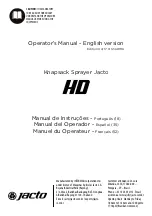
7/62
6.1. Storage recommendations for batteries
•
Store battery packs in clean, dry place and away from direct sunlight and ex-
cess heat or cold.
•
Store batteries out of reach of children.
•
For storage periods of more than one month, store battery with half charge.
This extends battery life.
7. Important Safety Instructions for Sprayers
DANGER!
• DO NOT spray flammable or combustible chemical
products.
This will result in serious risk of fire and
explosion.
• DO NOT spray acids or corrosive chemicals.
This will
result in serious risk of fire, explosion and leakage. Sprayer
parts can be permanently damaged.
cause a short circuit.
NOTE: Batteries should not be
put in checked baggage.
WARNING!
• DO NOT use the sprayer for purposes other than
spraying agricultural defensives approved by
competent authorities.
Always consider the following recommendations:
• Check sprayer before spraying.
Ensure there is no
leakage or missing parts. Do not use sprayer if it is not
in good condition.
• Do not eat, drink or smoke while spraying.
Serious
risk of poisoning.
• Do not mix chemical products, unless recommended
by manufacturer.
Intense chemical reactions can occur.
• Read the label of chemical products carefully.
Always
follow manufacturer’s recommendations.
• High pressure present at end of nozzle and inside
sprayer base.
Turn-off the sprayer completely and
release pressure before attempting to repair or replace
parts of the sprayer.
• Do not direct spray towards bystanders.
Spray
may be toxic.
• After the use of herbicides always clean the equip-
ment before using other formulations.
• Wear individual protection equipment.
Wear gloves,
safety glasses, safety mask and protective clothing.
• Clean yourself after spraying.
Take a shower with plenty
of soap and water. Put on clean clothes.
• The clothing used during spray application must be
washed separate from other clothes of ordinary use.
• Keep chemical products out of reach of children
and animals.
Lock up the chemical products to prevent
untrained persons from handling them.
• In case of intoxication, see a doctor immediately.
Show him/her the chemicals manufacturer’s label.
• Dispose of chemical containers properly.
Observe
your local regulatory agency recommendations and
follow manufacturer’s disposal instructions.
• Do not pollute the environment.
• During the transport in vehicles, the sprayer must be
turned off and secured.
Always keep the trigger valve
shut during transport and when not using the sprayer.
7.1. Triple rinse of empty agrochemicals containers
NOTE: Even the containers considered empty contain chemical residues. There-
fore, discarding the containers without washing out the residues is extremely dan-
gerous to man, animals and environment. In the case of metal, plastic and glass
chemical containers, each container must be rinsed three times to ensure the resi-
dues are completely removed. This manual describes how to make the triple rinse
in a correct, safe and effective way.
1.
Immediately after emptying the container, you must keep it with the
opening upside down over the sprayer tank opening or over the bucket
that you are using to prepare the chemical mixture for at least 30 seconds,
until no residue is left in the container, when the drops are falling in long
intervals.
2.
Hold the container in the upright position and fill it with water up to 1/4.
For example: in a 1000 ml container, put 250 ml of water.
3.
Install the container cap and tight it enough to avoid leakage during the
agitation.
4.
Agitate the container strongly in all ways (horizontal and vertical), for ap-
proximately 30 seconds to remove the residues that are on the container
internal walls.
5.
Take the container cap off and carefully pour the rinse water into the spray
tank.
6.
Keep holding the container over the spray tank opening for approximate-
ly 30 seconds to the last drop.
7.
Repeat this operation twice more. This way, you complete the triple rinse.
8.
Make the plastic and metallic containers useless by piercing the container
bottom with a pointed instrument. This way, their labels are not damaged
for identification purposes.
8. Preparation for use
8.1. Unpacking
Make sure the following components are in the box:
1
4
5
7
6
10
8
9
11
12
3
2








































